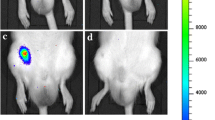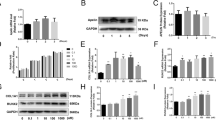Abstract
LIM mineralization protein-1 (LMP-1) is a novel intracellular osteogenic factor associated with bone development that has been implicated in the bone morphogenetic protein (BMP) pathway. This preliminary study evaluated the possibility of LMP-1-based retroviral gene therapy to stimulate osteoblast differentiation in vitro and fracture repair in vivo. A Moloney leukemia virus (MLV)-based retroviral vector to express LMP-1 with a hemagglutinin (HA) tag was developed, and its effects were evaluated on MC3T3-E1 cell differentiation and in the rat femur fracture model. MC3T3-E1 osteoblasts transduced with the MLV-HA-LMP-1 vector demonstrated significantly increased osteoblast marker gene expression (P < 0.05) and mineral deposition compared to control transduced cells. Femoral midshaft fractures were produced in Fischer 344 rats by the three-point bending technique. The MLV-HA-LMP-1 or control vector was applied at the fracture site through percutaneous injections 1 day postfracture. Analysis of fracture healing of 10 MLV-HA-LMP-1-treated and 10 control MLV-β-galactosidase (β-gal)–treated animals was completed at 3 weeks by X-ray, peripheral quantitative computed tomography, and histology. MLV-HA-LMP-1-treated animals had 63% more bone mineral content at the fracture site (P < 0.01), 34% greater total hard callus area (P < 0.05), and 45% less cartilage in the fracture callus (P < 0.05) compared to MLV-β-gal-treated animals. There was no effect of LMP-1 treatment on the density of the hard callus. Immunohistochemistry revealed expression of the LMP-1 transgene in the fracture callus at 21 days postfracture. Immunohistochemistry also revealed that LMP-1 transgene expression did not result in an increase in BMP-4 expression in the fracture callus. Compared to MLV-BMP-4 gene therapy studies, MLV-HA-LMP-1 gene therapy improved bony union of the fracture gap to a greater extent and did not cause heterotopic bone formation. This suggests that LMP-1 may be a better potential candidate for gene therapy for fracture repair than BMP-4. These exciting, albeit preliminary, findings indicate that LMP-1-based gene therapy may potentially be a simple and effective means to enhance fracture repair that warrants further investigation.






Similar content being viewed by others
References
Hannouche D, Petite H, Sedel L (2001) Current trends in the enhancement of fracture healing. J Bone Joint Surg Br 83:157–164
Einhorn TA (1995) Enhancement of fracture-healing. J Bone Joint Surg Am 77:940–956
Megas P (2005) Classification of non-union. Injury 36 (Suppl 4):S30–S37
Gruber R, Koch H, Doll BA, Tegtmeier F, Einhorn TA, Hollinger JO (2006) Fracture healing in the elderly patient. Exp Gerontol 41:1080–1093
Loder RT (1988) The influence of diabetes mellitus on the healing of closed fractures. Clin Orthop Relat Res 232:210–216
Koval KJ, Maurer SG, Su ET, Aharonoff GB, Zuckerman JD (1999) The effects of nutritional status on outcome after hip fracture. J Orthop Trauma 13:164–169
LeBoff MS, Kohlmeier L, Hurwitz S, Franklin J, Wright J, Glowacki J (1999) Occult vitamin D deficiency in postmenopausal US women with acute hip fracture. JAMA 281:1505–1511
Brinker MR, Bailey DE Jr (1997) Fracture healing in tibia fractures with an associated vascular injury. J Trauma 42:11–19
Dickson K, Katzman S, Delgado E, Contreras D (1994) Delayed unions and nonunions of open tibial fractures. Correlation with arteriography results. Clin Orthop Relat Res 302:189–193
Castillo RC, Bosse MJ, MacKenzie EJ, Patterson BM (2005) Impact of smoking on fracture healing and risk of complications in limb-threatening open tibia fractures. J Orthop Trauma 19:151–157
Simpson AH, Mills L, Noble B (2006) The role of growth factors and related agents in accelerating fracture healing. J Bone Joint Surg Br 88:701–705
Lieberman JR, Daluiski A, Einhorn TA (2002) The role of growth factors in the repair of bone. Biology and clinical applications. J Bone Joint Surg Am 84-A:1032–1044
Gerstenfeld LC, Cullinane DM, Barnes GL, Graves DT, Einhorn TA (2003) Fracture healing as a post-natal developmental process: molecular, spatial, and temporal aspects of its regulation. J Cell Biochem 88:873–884
Rundle CH, Wang H, Yu H, Chadwick RB, Davis EI, Wergedal JE, Lau KH, Mohan S, Ryaby JT, Baylink DJ (2006) Microarray analysis of gene expression during the inflammation and endochondral bone formation stages of rat femur fracture repair. Bone 38:521–529
Eckardt H, Ding M, Lind M, Hansen ES, Christensen KS, Hvid I (2005) Recombinant human vascular endothelial growth factor enhances bone healing in an experimental nonunion model. J Bone Joint Surg Br 87:1434–1438
Keila S, Kelner A, Weinreb M (2001) Systemic prostaglandin E2 increases cancellous bone formation and mass in aging rats and stimulates their bone marrow osteogenic capacity in vivo and in vitro. J Endocrinol 168:131–139
Jingushi S, Heydemann A, Kana SK, Macey LR, Bolander ME (1990) Acidic fibroblast growth factor (aFGF) injection stimulates cartilage enlargement and inhibits cartilage gene expression in rat fracture healing. J Orthop Res 8:364–371
Joyce ME, Roberts AB, Sporn MB, Bolander ME (1990) Transforming growth factor-beta and the initiation of chondrogenesis and osteogenesis in the rat femur. J Cell Biol 110:2195–2207
Kawaguchi H, Nakamura K, Tabata Y, Ikada Y, Aoyama I, Anzai J, Nakamura T, Hiyama Y, Tamura M (2001) Acceleration of fracture healing in nonhuman primates by fibroblast growth factor-2. J Clin Endocrinol Metab 86:875–880
Rundle CH, Miyakoshi N, Kasukawa Y, Chen ST, Sheng MH, Wergedal JE, Lau KH, Baylink DJ (2003) In vivo bone formation in fracture repair induced by direct retroviral-based gene therapy with bone morphogenetic protein-4. Bone 32:591–601
Einhorn TA, Majeska RJ, Mohaideen A, Kagel EM, Bouxsein ML, Turek TJ, Wozney JM (2003) A single percutaneous injection of recombinant human bone morphogenetic protein-2 accelerates fracture repair. J Bone Joint Surg Am 85-A:1425–1435
Yasko AW, Lane JM, Fellinger EJ, Rosen V, Wozney JM, Wang EA (1992) The healing of segmental bone defects, induced by recombinant human bone morphogenetic protein (rhBMP-2). A radiographic, histological, and biomechanical study in rats. J Bone Joint Surg Am 74:659–670
Boden SD, Liu Y, Hair GA, Helms JA, Hu D, Racine M, Nanes MS, Titus L (1998) LMP-1, a LIM-domain protein, mediates BMP-6 effects on bone formation. Endocrinology 139:5125–5134
Fei Q, Boden SD, Sangadala S, Viggeswarapu M, Liu Y, Titus L (2007) Truncated human LMP-1 triggers differentiation of C2C12 cells to an osteoblastic phenotype in vitro. Acta Biochim Biophys Sin (Shanghai) 39:693–700
Liu Y, Hair GA, Boden SD, Viggeswarapu M, Titus L (2002) Overexpressed LIM mineralization proteins do not require LIM domains to induce bone. J Bone Miner Res 17:406–414
Viggeswarapu M, Boden SD, Liu Y, Hair GA, Louis-Ugbo J, Murakami H, Kim HS, Mayr MT, Hutton WC, Titus L (2001) Adenoviral delivery of LIM mineralization protein-1 induces new-bone formation in vitro and in vivo. J Bone Joint Surg Am 83-A:364–376
Yoon ST, Park JS, Kim KS, Li J, Attallah-Wasif ES, Hutton WC, Boden SD (2004) ISSLS prize winner. LMP-1 upregulates intervertebral disc cell production of proteoglycans and BMPs in vitro and in vivo. Spine 29:2603–2611
Sangadala S, Boden SD, Viggeswarapu M, Liu Y, Titus L (2006) LIM mineralization protein-1 potentiates bone morphogenetic protein responsiveness via a novel interaction with Smurf1 resulting in decreased ubiquitination of Smads. J Biol Chem 281:17212–17219
Zhao M, Qiao M, Oyajobi BO, Mundy GR, Chen D (2003) E3 ubiquitin ligase Smurf1 mediates core-binding factor alpha1/Runx2 degradation and plays a specific role in osteoblast differentiation. J Biol Chem 278:27939–27944
Zhao M, Qiao M, Harris SE, Oyajobi BO, Mundy GR, Chen D (2004) Smurf1 inhibits osteoblast differentiation and bone formation in vitro and in vivo. J Biol Chem 279:12854–12859
Sangadala S, Boden SD, Metpally RP, Reddy BV (2007) Modeling and analysis of molecular interaction between Smurf1-WW2 domain and various isoforms of LIM mineralization protein. Proteins 68:690–701
Kim HS, Viggeswarapu M, Boden SD, Liu Y, Hair GA, Louis-Ugbo J, Murakami H, Minamide A, Suh DY, Titus L (2003) Overcoming the immune response to permit ex vivo gene therapy for spine fusion with human type 5 adenoviral delivery of the LIM mineralization protein-1 cDNA. Spine 28:219–226
Wu R, Durick K, Songyang Z, Cantley LC, Taylor SS, Gill GN (1996) Specificity of LIM domain interactions with receptor tyrosine kinases. J Biol Chem 271:15934–15941
Rundle CH, Strong DD, Chen ST, Linkhart TA, Sheng MH, Wergedal JE, Lau KH, Baylink DJ (2008) Retroviral-based gene therapy with cyclooxygenase-2 promotes the union of bony callus tissues and accelerates fracture healing in the rat. J Gene Med 10:229–241
Peng H, Chen ST, Wergedal JE, Polo JM, Yee JK, Lau KH, Baylink DJ (2001) Development of an MFG-based retroviral vector system for secretion of high levels of functionally active human BMP4. Mol Ther 4:95–104
Strohbach C, Kleinman S, Linkhart T, Amaar Y, Chen ST, Mohan S, Strong D (2008) Potential involvement of the interaction between insulin-like growth factor binding protein (IGFBP)-6 and LIM mineralization protein (LMP)-1 in regulating osteoblast differentiation. J Cell Biochem 104:1890–1905
Livak KJ, Schmittgen TD (2001) Analysis of relative gene expression data using real-time quantitative PCR and the 2(-Delta Delta C(T)) method. Methods 25:402–408
Bonnarens F, Einhorn TA (1984) Production of a standard closed fracture in laboratory animal bone. J Orthop Res 2:97–101
Alkhiary YM, Gerstenfeld LC, Krall E, Westmore M, Sato M, Mitlak BH, Einhorn TA (2005) Enhancement of experimental fracture-healing by systemic administration of recombinant human parathyroid hormone (PTH 1–34). J Bone Joint Surg Am 87:731–741
Boden SD, Titus L, Hair G, Liu Y, Viggeswarapu M, Nanes MS, Baranowski C (1998) Lumbar spine fusion by local gene therapy with a cDNA encoding a novel osteoinductive protein (LMP-1). Spine 23:2486–2492
Riviere I, Brose K, Mulligan RC (1995) Effects of retroviral vector design on expression of human adenosine deaminase in murine bone marrow transplant recipients engrafted with genetically modified cells. Proc Natl Acad Sci USA 92:6733–6737
Zhang XS, Linkhart TA, Chen ST, Peng H, Wergedal JE, Guttierez GG, Sheng MH, Lau KH, Baylink DJ (2004) Local ex vivo gene therapy with bone marrow stromal cells expressing human BMP4 promotes endosteal bone formation in mice. J Gene Med 6:4–15
Gysin R, Wergedal JE, Sheng MH, Kasukawa Y, Miyakoshi N, Chen ST, Peng H, Lau KH, Mohan S, Baylink DJ (2002) Ex vivo gene therapy with stromal cells transduced with a retroviral vector containing the BMP4 gene completely heals critical size calvarial defect in rats. Gene Ther 9:991–999
Roe T, Reynolds TC, Yu G, Brown PO (1993) Integration of murine leukemia virus DNA depends on mitosis. EMBO J 12:2099–2108
Iwaki A, Jingushi S, Oda Y, Izumi T, Shida JI, Tsuneyoshi M, Sugioka Y (1997) Localization and quantification of proliferating cells during rat fracture repair: detection of proliferating cell nuclear antigen by immunohistochemistry. J Bone Miner Res 12:96–102
Acknowledgements
The authors thank Dr. David J. Baylink for establishing the Gene Therapy Group at the Loma Linda VA Medical Center; Dr. Gordon Gill for providing the Enigma cDNA clone for the development of a retroviral vector for these studies; and Ryan Porte, Nancy Lowen, and Audrey Delgado for excellent technical support. This research was funded by a VA Merit Award, a Musculoskeletal Disease Center Congressional Appropriation, and the Medical Scientist Training Program at Loma Linda University.
Author information
Authors and Affiliations
Corresponding author
Rights and permissions
About this article
Cite this article
Strohbach, C.A., Rundle, C.H., Wergedal, J.E. et al. LMP-1 Retroviral Gene Therapy Influences Osteoblast Differentiation and Fracture Repair: A Preliminary Study. Calcif Tissue Int 83, 202–211 (2008). https://doi.org/10.1007/s00223-008-9163-0
Received:
Accepted:
Published:
Issue Date:
DOI: https://doi.org/10.1007/s00223-008-9163-0




